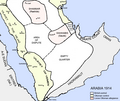Portal:Saudi Arabia
The Saudi Arabia Portal – بوابة المملكة العربية السعودية
Saudi Arabia, officially the Kingdom of Saudi Arabia (KSA), is a country in West Asia and the Middle East. It covers the bulk of the Arabian Peninsula and has a land area of about 2150000 km2 (830000 sq mi), making it the fifth-largest country in Asia and the largest in the Middle East. It is bordered by the Red Sea to the west; Jordan, Iraq, and Kuwait to the north; the Persian Gulf, Qatar and the United Arab Emirates to the east; Oman to the southeast; and Yemen to the south. Bahrain is an island country off its east coast. The Gulf of Aqaba in the northwest separates Saudi Arabia from Egypt and Israel. Saudi Arabia is the only country with a coastline along both the Red Sea and the Persian Gulf, and most of its terrain consists of arid desert, lowland, steppe, and mountains. The capital and largest city is Riyadh; the kingdom also hosts Islam's two holiest cities of Mecca and Medina. (Full article...) Selected article -The COVID-19 pandemic in Saudi Arabia is part of the worldwide pandemic of coronavirus disease 2019 (COVID-19) caused by severe acute respiratory syndrome coronavirus 2 (SARS-CoV-2). The first case in the kingdom was confirmed by the Ministry of Health on 2 March 2020 and in the following months, the kingdom held the highest number of confirmed cases in the Arab states of the Persian Gulf. The kingdom announced the suspension of all domestic and international travel on March 21; domestic travel was reinitiated on May 21. After curfews and lockdowns were placed on several administrative levels, the number of daily confirmed cases shrunk dramatically and by June 21, all curfews were lifted through a three-phase program enacted throughout the country, except the city of Mecca. By mid-July, the kingdom was seeing more daily recoveries than cases. The Hajj took place with only 10,000 socially-distanced pilgrims allowed to take part in the annual pilgrimage, which fell during the last week of July and the first week of August. (Full article...)Did you know (auto-generated)
News
Related portalsReligions in Saudi Arabia Arab states WikiProjectsThings you can do
This is a Good article, an article that meets a core set of high editorial standards.
 The McMahon–Hussein Correspondence is a series of letters that were exchanged during World War I in which the Government of the United Kingdom agreed to recognize Arab independence in a large region after the war in exchange for the Sharif of Mecca launching the Arab Revolt against the Ottoman Empire. The correspondence had a significant influence on Middle Eastern history during and after the war; a dispute over Palestine continued thereafter. The correspondence is composed of ten letters that were exchanged from July 1915 to March 1916 between Hussein bin Ali, Sharif of Mecca and Lieutenant Colonel Sir Henry McMahon, British High Commissioner to Egypt. Whilst there was some military value in the Arab manpower and local knowledge alongside the British Army, the primary reason for the arrangement was to counteract the Ottoman declaration of jihad ("holy war") against the Allies, and to maintain the support of the 70 million Muslims in British India (particularly those in the Indian Army that had been deployed in all major theatres of the wider war). The area of Arab independence was defined to be "in the limits and boundaries proposed by the Sherif of Mecca" with the exception of "portions of Syria" lying to the west of "the districts of Damascus, Homs, Hama and Aleppo"; conflicting interpretations of this description were to cause great controversy in subsequent years. One particular dispute, which continues to the present, is the extent of the coastal exclusion. (Full article...)Selected pictureMore did you know
General imagesThe following are images from various Saudi Arabia-related articles on Wikipedia.
Featured contentFeatured articlesGood articles
Associated WikimediaThe following Wikimedia Foundation sister projects provide more on this subject:
Sources
Discover Wikipedia using portals | ||||






![Image 1A view of Jabal Sawda, a peak located in Saudi Arabia, with an elevation of around 3,000 metres (9,843 ft).[1]](http://upload.wikimedia.org/wikipedia/commons/thumb/5/59/Al_Sawda_peak.jpg/120px-Al_Sawda_peak.jpg)






















































